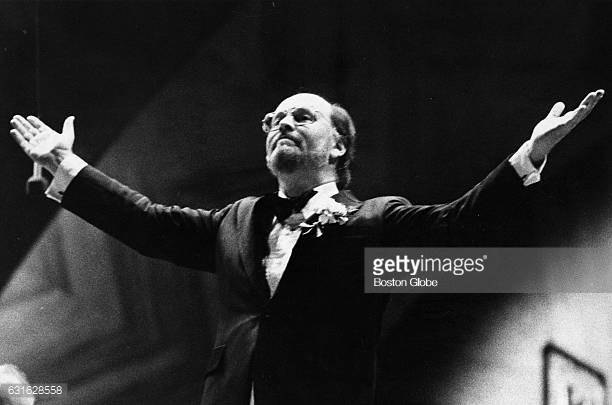- Popular Post
-
Posts
4,765 -
Joined
-
Days Won
6
Posts posted by SteveMc
-
-
I saw the movie a few years back. Very broad and romantic, eclectic. Maybe a bit stiff.
Score is by far the best part.
The leads are super easy on the eyes, though.

-
Colwyn and Lyssa is plenty emotional as it is, and all the better for not being as obvious about it as some of his later material in the vein.
-
- Popular Post
- Popular Post
The Jane Eyre Suite would be just perfect.
-
Winter Games Fanfare (1989)
Rather obscure short occasional overture composed not for the Olympics, but for the 1989 Alpine Ski Championships in Vail, Colorado.
Has a pretty memorable theme, very JW structure and direction.
The Denver Brass gives it a go here in what appears to be the original arrangement.
-
3 minutes ago, Pawel P. said:
No more than Netflix.
Of course they won't. What would be the point of that?
Just don't want to leave anything to chance.
-
Will livestream tickets be limited?
Seems I need to purchase a week long package (or free trial subscription) to be able to watch cheaply.
-
1 hour ago, Jay said:
I guess he had the violin concerto in '74 as well, though I don't know when he wrote that or when it premiered. But I always thought at least part of that concerto was him processing his grief over Barbara's death
He began the concerto, or at least Barbara urged him to write it, before she died in 1974, but he finished it in 1976.
So, probably the lion's share of it was written after her death and deals with his feelings of that time.
The second movement is specifically dedicated to her memory.
- Jay and Chris ChrusherComix
-
 2
2
-

Presumed Innocent
Nice mystery where Ford continues to transition from 80s action hero to 90s everyman.
A lot is made of how Ford's character is an effective passive protagonist, but this works since the central action of the character is his choice to have an affair. The rest is a morality play. We now want to see how he will get his comeuppance for that and for the murder he just may have committed. When it seems he will get away with it all, the level of suspense jumps through the roof. Something must be coming, because that is how morality plays work. And this one's ending does not disappoint.
Stylistically, the movie has that warm late 80s/early 90s feeling, which I normally love, but here it feels just a bit conventional for the proceedings.
Oh, and there is a John Williams score, mostly a theme and variations sort of thing. Works well.
3.5/4
-
1 hour ago, Falstaft said:
Hi everyone. I thought it might be useful to put together a listening guide of sorts for Williams's second violin concerto. This struck me as appropriate given the fact it's going to be heard in performance again fairly soon, and the piece, particularly its first movement, is fairly difficult to grasp on first listen!
I've only put together a guide to the first movement (by far the most challenging), but if this is indeed helpful I'll consider doing the other three--or maybe someone else would like to. It's quite difficult to do this without a score, to put it mildly, so take everything here as provisional. I'm surely missing quite a lot of important details...
Listening Guide for John Williams, Violin Concerto 2
MOVEMENT 1: "PROLOGUE"
Overall, the most formally loose and spontaneous-seeming movement, fitting given Williams's striving for a "quasi-improvisatory" character. Not a truly non-repetitive piece, however: there are both aspects of inner-movement unity and some subtle prefiguring of material to come, particularly the concerto's principle "leitmotif" introduced in the 2nd Movement. The unpredictability of the music on a measure-to-measure level is compensated by an extremely clear division of 6 large-scale sections, summarized below.
More in-depth account:
SECTION 1 – INTRODUCTION- 0:00 Quiet, slow introduction showcasing harp, supported by bed of strings. Shape of opening harp melody (D3-E3, D3-E3-C3-A3-D3) vaguely anticipates some later motivic details. First harp-based subphrase tonally centered on B♭-lydian, with contrasting Gm6(♭13) in middle. Second, string-based subphrase more dissonant, melodically disjunct. The third, once again harp-based subphrase coalesces on Dmaj6/min chord.
- 1:11 Introduction of soloist. Violin begins with repetition of note F4, giving bluesy quality to faint D-major tonality maintained by strings/harp. Melodic D tonic flanked by tritones A♭4 & G♯3 above and below. Progressively expands range upward, with what will become a quasi-motivic repeated note figure, here on B♭4 and E♭5. Thinner texture and new harmonies (F♯m and A-dim) and octatonic scale-fragment in violin at 1:50, followed by downwards chromatic cascades and melodic peak of E♭6. Unaccompanied violin sags glumly back downwards.
SECTION 2 – FAST AND TURBULENT
- 2:24 Pulsing, agitated pattern in orchestra midrange on dissonant harmony (A3+B♭3+C4+ D♭4), supported at unpredictable intervals by rising bass-figure starting on low D. Violin gathers energy with repetition of Eb4, proceeds to a flowing, unpredictable musical thought, up to the first of several big orchestral swells marked by dissonant chord and percussive punctuation that swallows up soloist.
- 2:46 Violin reasserts itself over motivic rising bass-figure. Pace of textural and melodic change speeds up considerably, and music becomes increasingly key-less, violin and orchestra exchanging frenzied, short-lived ideas. Particular prominence to harp, timpani, clarinet. Low-strings trade downwards arpeggio of important Gm9 chord, echoed by violin (3:09), and Em9♭5, F♯dim7.
- 3:16 Lighter but more dissonant texture. Spiky, progressively accelerating violin writing against unpredictable staccato wind and pizzicato bursts.
- 3:33 Arpeggiating eighth-note figures in low strings resume, now upwards (D2-B♭2-D3-G2-C3-E♭3, etc.), quickly losing tonal focus as another dissonant tutti swell overtakes violin, followed by brief timpani solo (3:44).
- 3:46 Purely orchestral climax. Dissonant pitch pyramid assembled over B pedal. Similarly vaulting bass figures under now unified upper strings in octaves on urgent melody, arching upwards in successive swells. Pulsing/sustained brass and string melody help refocus tonality onto D, and downwards chord progression (D--C--B), while dissonant, can be referred to D-center. Ends on a shrieking tutti cluster, similar to opening sonority of section but greatly intensified.
SECTION 3 – SLOW AND TRANSPARENT
- 4:23 Dreamy extended-tertian sonorities, starting with and centered on Gm13 (chord anticipated at 3:11, arpeggiated texture anticipated at 3:33). Violin enters with comparatively lyrical theme with pronounced downwards-moving trajectory. Tonality shifts to Dm, moving stepwise to Fm. Melodic shape heard in passing at 5:00 (F5-E5-G♯5-C5) seems to anticipate the recurring “leitmotif” of movements 2 & 4 -- you know, the one that sounds a bit like "Moonlight" from Sabrina.
- 5:10 Clear sense of tonality dissolves, violin becomes more agitated, emphasis on dotted rhythms, brief mini-solo of dissonant stops (5:18-5:22). Followed by dense, highly dissonant wind-ensemble writing, drawn from immediately preceding violin solo and segueing back into it.
- 5:39 Deep, dark minor chords (C♯m--Caug) prepare a catchy but ominous melody for solo violin built on double-stops (parallel minor 6ths), again with contour (A♭4-A♭4-G4-B4-C4) that anticipates shape of recurring leitmotif from mvts 2 & 4.
- 5:50 Busily spinning passagework for violin and glittering accompaniment, foreshadowing movement 2, recedes to background to allow brief flute solo (B♭4-A4-E5-G5-F♯5-F♯4) in E-minor, suggestive but as far as I can tell not motivically derived from anything else. Violin follows-through with flute melody, seamlessly moving to a…
- 6:20 Pre-cadenza for violin and harp, again with elements of flute melody (G6-F♯6-A5…B♭5-D♭6-C6-C5)
SECTION 4 – CADENZA
- 6:50 Succession of contrasting technical and expressive ideas, not a huge degree of thematic connectivity with preceding sections though fairly consistent within its own scope.
(Substructure: Downwards Em/B♭ chords—leaping octave pairs—compound melody (E6-D♯6-B5-A♯5, D♭6-C6-A5-G♯5)—trills—resigned droop—gathering energy—ascending melody over pedal—arpeggios—trills—melody reminiscent of VC1—ascending passagework maxing out at A6—descending, harsh stops, ending with repeated D4.)
SECTION 5 – BROAD AND CLIMACTIC
- 8:38 Rather spooky melody for violin (F♯4-D5-B♭6-F♯5) over brief suggestion of B-minor. Quickly yields to new material for orchestra, with massed brass, strings in octaves, and thick, repeating wind quasi-fanfares, all grounded over low C-pedal (C-A♭-D♭-G chord?). Classic JW concert music stuff (c.f. For Seiji, Soundings, Heartwood, etc.). Much of this seems to respond vaguely to material introduced in the Cadenza.
- 9:00 Almost aleatoric sounding passage for harp, solo high winds, pizz strings.
- 9:09 Emphasis on low winds and strings. Recollection of ascending bass figure from 3:33 (now E2-B2-D3, F♯2-B2-E3)
- 9:14 Climax building really starts in earnest. Wind chords seem to outline violin’s spooky melody from start of section, against aggressive massed-string section counterpoint, ending on bright, dissonant wind chord.
- 9:25 Violin solo reasserts self, now more actively interacting with rest of orchestra. Strong sense of rhythmic and harmonic acceleration, climax building pauses after timpani interjection (9:40).
- 9:48 Final, rapidly attained climax, fastest solo violin writing; impression of huge sweeping motions from whole orchestra, culminating on a huge tutti chord of characteristically JW-dissonant flavor (A-C-E- F-A♭-C♭)
SECTION 6 – AFTERMATH AND CODA- 10:11 Instantly quiet, clear duet for harp and violin. Clear reminiscence of beginning of Section 3, via repeated harp arpeggio of extended triadic sonority, this time F♯m11(b♭13) instead of Gm11(nat13). Meditative violin solo above, not clearly connected to previous themes.
- 10:40 Quiet upwards scurrying from violin, reaching high B6, followed by abrupt, staccato motif (second phrase accompanied by four dissonant pizzicato chords from rest of string section).
- 11:03 Violin settles on sustained low A♭3, against resonant F2-A1 bass support on harp. Full fade-out by 11:16.

-
- Popular Post
To Lenny! To Lenny! (1988)
or For New York (Variations on Themes By Leonard Bernstein)
Short piece written to celebrate the great Leonard Bernstein's 70th birthday and premiered by Williams and the Boston Symphony at Tanglewood, this composition, which goes by two names, is a brief exploration of some Bernstein tunes in a very John Williams way regarding direction and orchestration. It is an enjoyable little musical aperitif.
Here it is recorded by Williams himself.
-

Darkest Hour (2017)
This is not the somber, reverent historical drama that the title and the subject would lead you to expect. Indeed, historical liberties are in abundance. What this movie is instead is a dramatic presentation built around a historical event and larger than life national figure. All this becomes extremely clear when Churchill descends into the Tube, for a Henry V style scouting of the opinion and feelings of those doing the fighting. Here, Churchill, in his embodiment of Britain, seeks guidance from how the common folk feel about the present European menace. Do they want to follow the elite and make peace with it all, or do they want to embrace a defiant civic nationalism, and along with that bastion of tradition the monarchy, and with the nations of the colonial legacy, hold on and hold out to remain a truly free England. They choose the latter, and the movie seems to say this message should be heeded now too.
Oldman's performance is, of course, great. Lily James is a breath of fresh air as well. Everything moves with purpose and engagement in Wright's direction. Only the lighting is a bit off, but maybe it just reinforces how the whole proceedings are pretty much a cinematic play.
Solid all around.
3.5/4
-
On 8/5/2021 at 10:29 AM, AC1 said:
I vividly remember Gruesome going through a Sabrina phase. But maybe it was someone else. Jay is right, my memory can't be trusted.
Maybe he did, but it was Bespin who I remember fell head over heels for the score.
-
- Popular Post
- Popular Post
Zimmer has his very solid moments, but he is essentially a pop film composer and this colors his sensibilities in composition and production in a way that rubs wrong with my sensibilities.
Horner was a postmodernist classical composer who rebelled against the establishment by embracing the form of pop film composing. Stuff like Krull, The Land Before Time, Braveheart, and The Spitfire Grill are works of artistic vision and integrity at a level that Zimmer will probably never match.
Honestly, Zimmer is probably a more effective film scorer than Horner was, but Horner was the better composer.
- Taikomochi, blondheim, Holko and 2 others
-
 5
5
-
-
1 hour ago, Tom said:
Williams need to stop fiddling with it (sorry) and release the definitive version. I would prefer he go back to the original, but such is life.
The third movement in the 2016 revision is wildly different in particular. I think I like it a good deal. But I agree the original version is the one that should probably be "canon." No other version comes close to me in the power of the first movement and the aching beauty of the second.
-
I think the Violin Concerto No. 2 might just become a premier piece for top level violinists and orchestras to show their chops in recordings.
The first concerto I feel has a better chance at entering the repertoire, though, with its more standard structure and thematic drive, the Adagio especially exemplifying all that.
Still, that has not happened yet. But I've got to maintain that it is right up there with the Berg as one of the great violin concertos of the 20th century.
-
4 minutes ago, D_nev said:
I am not sure if this is something that is acceptable to post on here (and please feel free to delete if so) but I compiled the Concerto into separate movements from the CRB link posted in another thread if anyone is interested. I can share a Dropbox link of that is something allowed?
No, that's not typically allowed over here on the board.
-
2 minutes ago, Tom said:
I think the official name is Fanfare for 10 Years Old, as in commemorating an anniversary versus kids, but yes the youtube video has it the other way. The piano reduction is cool. I would love to hear the full piece.
That would make much, much more sense. Every listing of JW concert works I've come across online, including Wikipedia, has it as Fanfare For Ten Year Olds, but the details in @Thors thread above would seem to support the anniversary intention.
-
Fanfare for Michael Dukakis (1988)
Today, two John Williams fanfare/occasional pieces, both relatively obscure and minor works in his concert oeuvre.
First, the Fanfare for Michael Dukakis, written it appears in a span of three weeks for the 1988 Democratic National Convention, with Williams being connected to Presidential hopeful Dukakis through the candidate's father-in-law Harry Ellis Dickson, a Boston Pops associate conductor.
It seems the live premiere is the only recording we have of the piece.
Fanfare For Ten Year Olds(1988)
Very obscure piece this. Pretty much all the available information is in this thread:
A recording exists, but has not surfaced to YT. Some details in the above thread.
Here is a performance video of the work in piano reduction form.
-
-
-
We are about one month out from the concert series now. Things are looking a little more uncertain now virus wise, but perhaps we could still make some tentative plans for a West Coast JWFan meetup?
-
-

Joker (2019)
We live in a society. Fortunately, it is not quite as bleak as the society in this movie, no matter how relevant and important the movie seems to think it is. Todd Phillips is to be commended, though, for making a movie that is not afraid to stand out a little, do its own thing, even if that thing feels very obviously indebted to the likes of Scorsese and Nolan, if more humorous. Thematically, the movie is a little confused, however. It wants to be about too much, from mental illness, to Wall Street, to current politics, and ends up not speaking to anything particularly well. Phoenix's over the top Oscar winning performance is part Travis Bickle, part demented Kaufman, and all Joaquin Phoenix. He never loses himself in the Fleck/Joker character, the audience is always aware of the him and all the mannerisms and shirtless gallivanting come off as self-indulgent somehow.
Guðnadóttir's score is surprisingly frank about its role in the movie, upfront without much apology, and I appreciated that even if its style is not my cup of tea, really.
3/4





The piece of music you associate with outer space / space travel the most
in General Discussion
Posted
You know what's funny?
I don't associate a lot of "space music" with Space.
Like Star Wars I associate with heroism, CE3K with myth and human triumph, Star Trek with exploration and human progress, Moonraker with what Bespin said.
But The Planets, which is not really about space at all, I do associate with space!